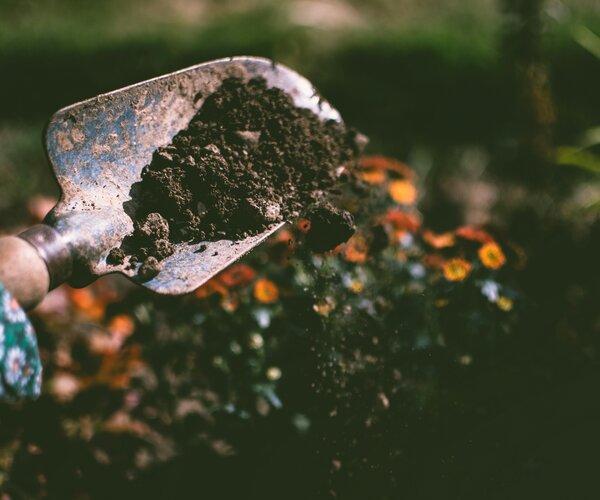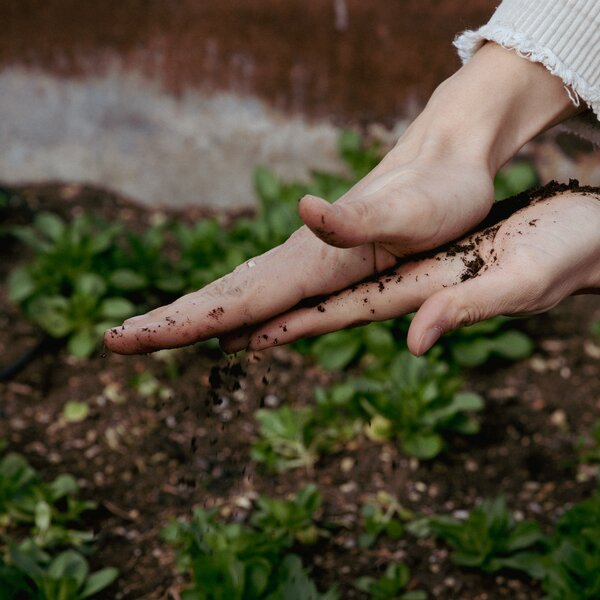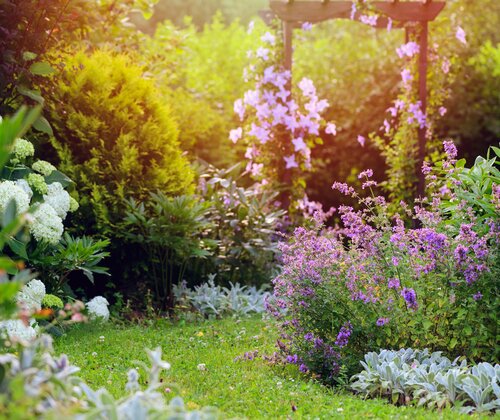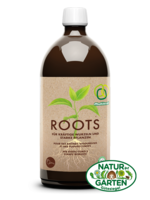
Soil lifeline: unlocking the magic of soil in your own garden
Soil is the basis of all horticultural work. It is more than just the soil beneath our feet - it is a living ecosystem that forms the basis for the growth of healthy plants. On a small and large scale, in the garden and in the field. Here you can find out how to determine the type of soil in your garden, what humus is all about and how you can increase the humus content in your soil with the help of simple measures.

On the importance of soil fertility
Soil fertility is the foundation of a healthy ecosystem. It plays a decisive role in healthy and productive plant growth in the garden and in the field. Yields and plant health make it easy to recognise whether a soil is fertile and revitalised. It is essential to remember that the plant is always considered as a whole: with its above-ground and underground parts, i.e. the shoot - everything that grows above the soil surface - and roots.
The question always arises as to whether the selected plants are also suitable for the given soil type and can spread their widely ramified root system there.
Soil types and how they are composed
The soil type describes the composition and structural properties of the soil. It is determined by the proportion of mineral components such as sand, silt and clay, as well as organic materials.
Basically, soil consists of "coarse soil" (stones larger than 2 mm) and "fine soil" (particles between 2 mm and 2 µm in size). In between is humus, which makes the soil loose and rich in nutrients.
Depending on the composition, there are different types of soil that are relatively easy to distinguish and recognise.
Soil fertility is the foundation of a healthy ecosystem. It plays a decisive role in healthy and productive plant growth in the garden and in the field. Yields and plant health make it easy to recognise whether a soil is fertile and revitalised. It is essential to remember that the plant is always considered as a whole: with its above-ground and underground parts, i.e. the shoot - everything that grows above the soil surface - and roots.
The question always arises as to whether the selected plants are also suitable for the given soil type and can spread their widely ramified root system there.
Soil types and how they are composed
The soil type describes the composition and structural properties of the soil. It is determined by the proportion of mineral components such as sand, silt and clay, as well as organic materials.
Basically, soil consists of "coarse soil" (stones larger than 2 mm) and "fine soil" (particles between 2 mm and 2 µm in size). In between is humus, which makes the soil loose and rich in nutrients.
Depending on the composition, there are different types of soil that are relatively easy to distinguish and recognise.

Soil analysis
The type of soil varies depending on the location. It can only be influenced to a limited extent, but it is always possible to make the best of the situation. Knowledge of the soil composition allows conclusions to be drawn about the ideal soil cultivation. You can find out which soil is in your garden with this simple test, the so-called finger test:
Knead a piece of soil the size of a walnut and quickly mould it into a pencil-thick cylinder between your hands. The base should be slightly moist.
So how do you recognise which soil it is?
- Sand bottom
- The roll cannot be rolled out and crumbles very easily
- Grains of sand can be seen and felt
- Loamy sandy soil
- The roll crumbles but can be moulded
- Small glittering particles are visible (this is clayey material)
- Sandy clay soil
- The roll does not crumble
- Sand can be clearly felt between the fingers
- Clay soil
- The roll can be rolled out thinner than 4 mm without crumbling
- Sand is barely noticeable
- The palms of the hands are shiny after rolling out
How can I utilise my soil?
Sandy soil
Sandy soils allow water to flow through easily, are well aerated and can be worked easily. However, due to its fine structure, it cannot hold water very well, which is why a regular water supply is necessary. Nutrients are also easily washed out. This is why these soils should be supplied with plenty of compost or bokashi. Mulching helps to prevent the soil from drying out too much.
Suitability: Suitable for vegetables and fruit. Important for good yields: regular water supply, organic fertilisation and mulch.
Clay soil
Loamy soil contains all the different grain sizes of sand, silt and clay. This composition guarantees the ideal storage of water and nutrients, making clay soil the ideal basis for organic gardening. It warms up very quickly in spring due to the sand it contains, is easy to work and is easily rooted by the plants.
Suitability: Excellent for vegetables and fruit.
Clay soil
Clay soils have a tendency to become very compacted. As a result, they are poorly aerated. Quartz sand can be worked in to achieve a better supply of oxygen. In general, clay soils should be cultivated carefully. Deep-rooted green manures, for example with winter vetch, phacelia or lucerne, loosen the soil and thus improve its texture.
Suitability: Suitable for vegetables if it is turned over every few years.
Sandy soil
Sandy soils allow water to flow through easily, are well aerated and can be worked easily. However, due to its fine structure, it cannot hold water very well, which is why a regular water supply is necessary. Nutrients are also easily washed out. This is why these soils should be supplied with plenty of compost or bokashi. Mulching helps to prevent the soil from drying out too much.
Suitability: Suitable for vegetables and fruit. Important for good yields: regular water supply, organic fertilisation and mulch.
Clay soil
Loamy soil contains all the different grain sizes of sand, silt and clay. This composition guarantees the ideal storage of water and nutrients, making clay soil the ideal basis for organic gardening. It warms up very quickly in spring due to the sand it contains, is easy to work and is easily rooted by the plants.
Suitability: Excellent for vegetables and fruit.
Clay soil
Clay soils have a tendency to become very compacted. As a result, they are poorly aerated. Quartz sand can be worked in to achieve a better supply of oxygen. In general, clay soils should be cultivated carefully. Deep-rooted green manures, for example with winter vetch, phacelia or lucerne, loosen the soil and thus improve its texture.
Suitability: Suitable for vegetables if it is turned over every few years.
What is humus?
In addition to the mineral components in the soil, there are also organic components. These consist largely of humus. The humus content is largely responsible for soil fertility. It absorbs water and slowly releases it back to the plants. It counteracts erosion and leaching. It is dark in colour, warms up quickly and allows the soil to be worked early in the spring.
Humus refers to the entirety of all dead components in the soil. These are the remains of animals, plants, fungi and bacteria. These organic remains serve as food for earthworms and all other animals, such as microorganisms in the soil, which decompose them into simpler compounds. The humic substances produced in the process give these humus-rich soils a dark colour. Humic substances bind nutrients and in turn make them available to plants.
Humus-rich soils store water better and for longer - a clear advantage in hot summers! This ensures healthy plants and rich yields. The humus content in garden soil should be at least 4%. This small amount makes the difference between success and failure in the vegetable patch. It is also important that the content is increased annually, or at least kept constant.
Sources: Heistinger, Andrea: Basiswissen Selbstversorgung aus Biogärten. Individuelle und gemeinschaftliche Wege und Möglichkeiten. 186-190 Löwenzahn in der Studienverlag Ges.m.b.H, 2018.
Sources: Heistinger, Andrea: Basiswissen Selbstversorgung aus Biogärten. Individuelle und gemeinschaftliche Wege und Möglichkeiten. 186-190 Löwenzahn in der Studienverlag Ges.m.b.H, 2018.

Wooden floors are very popular because of their unique look. The sustainable material radiates warmth and naturalness, feels good and grounding and is generally extremely durable. Find out how to take good care of your floorboards and make them shine with the eMC cleaners from Multikraft from our expert Barbara Enengel in our new series "Multiwissen - Barbara's effective tips for every home"

We divide the year into four seasons, but there is an even finer division into ten seasons, which is biologically based and depends on the phenomena in nature. These occur at different times each year, depending on the development of the plant world. We therefore distinguish between the astronomical or calendar seasons and the phenological seasons. Here you can find out which seasons we are talking about and how you can utilise this classification in your garden.

